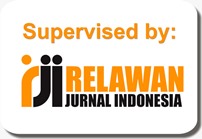ANALYSIS OF THE EFFECT OF FIRM SIZE AND EARNINGS PER SHARE ON FINANCIAL DISTRESS DURING THE COVID-19 PANDEMIC IN INDONESIA
Abstract
The method used is the Altman's Z-Score model, which is known to be accurate in predicting financial distress. From 780 listed public companies, after a purposive sampling selection process, 281 companies were obtained as samples. Data analysis using binary logistic regression shows that company size has a significant negative effect on financial distress; the larger the company size, the higher the Altman Z-score value, which means the risk of financial distress is lower. However, EPS does not show a significant effect on financial distress, although higher EPS reflects a lower risk of financial distress, this may be because EPS does not sufficiently describe the company's financial condition as a whole.
Keywords:Financial Distress, Firm Size, Earnings Per Share
Full Text:
PDFReferences
Altman, E.I., & Sabato, G. (2021). "The Z-score bankruptcy model: A review." Journal of Business Research, 123, 20-29.
Alfiyanti, M., & Pratiwi, DN (2015). Comparative Analysis of the Altman Model and the Springate Model to Predict Financial Distress. Scientific Work of Accounting, Sawunggalih Aji Polytechnic, 2(1), 75– 85.
Altman, E. I. (1968). Financial Ratios, Discriminant Analysis and The Prediction of Corporate Bankruptcy. The Journal of Finance Vol. XXIII No. 4, September 1968.
Altman, Edward I. (2000). Predicting Financial Distress of Companies: Revisiting the Zscore and Zeta ® Models. New York University: Stern School of Business.
Basyaib, Fachmi. 2007. Corporate Finance. Jakarta: Kencana.
Beaver, William H. (1966), Financial Ratios as Predictors of Failure, Empirical Research in Accounting, Selected Studies and Discussions by Preston K Mears and By John Neter, pp.71-127.
Bergh, D.D., Connelly, B.L., Ketchen, D.J., & Shannon, L.M. (2014). Signaling theory and equilibrium in strategic management research: An assessment and a research agenda. Journal of Management Studies.
Bharath, S.T., & Shumway, T. (2022). "Forecasting default with the Merton model: Evidence from emerging markets." Journal of Financial Economics, 143(1), 1-15.
Brigham, EF, & Houston, JF (2018). Fundamentals of Financial Management. Jakarta: Salemba Empat.
Eungene F. Brigham and Joel F. Houato. (2001). Financial Management, Erlangga, Jakarta. p. 36.
Damodaran, A. 1997. Corporate Finance Theory and practice. New York: John Willey & Sons, Inc.
Feng, W., & Zhang, Y. (2022). "The impact of corporate governance on financial distress: Evidence from the hospitality industry." International Journal of Hospitality Management, 102, 103126. [DOI: 10.1016/j.ijhm.2021.103126]
Ghozali, Imam. (2016). Multivariate Analysis Application with IBM SPSS 23 Program. Semarang: BPFE Diponegoro University.
Hadi, Syamsul and Anggraeni, Atika, (2008). Selection of the Best Delisting Predictor (Comparison Between The Zmijewski Model, The Altman Model, and The Springate Model, XI National Accounting Symposium, Pontianak.
Huayu, Shen, Mengyao Fu, Hongyu Pan, Zhongfu Yu & Yongquan Chen. (2020). The Impact of the COVID-19 Pandemic on Firm Performance, Emerging Markets Finance and Trade. Volume 56.
Huang, Y., & Song, H. (2022). "Financial distress prediction in the context of emerging markets: Evidence from China." Emerging Markets Finance and Trade, 58(3), 623-640. [DOI: 10.1080/1540496X.2020.1771490]
Hutabarat F. 2020. Analysis of Company Financial Performance. Retrieved on: 21-09-2021.
Jogiyanto. (2000). Portfolio Theory and Investment Analysis, BPEE UGM, Yogyakarta. p. 570.
Kretarto, Agus. (2001). Investor Relations: Marketing and Corporate Financial Communications Based on Compliance. Grafiti Pers. p. 53.
Kumar, S., & Singh, P. (2023). "A comprehensive review of financial distress prediction models: A machine learning approach." Journal of Risk and Financial Management, 16(2), 83. [DOI: 10.3390/jrfm16020083]
Luciana Spica Almilia, and Kristijadi. (2003). Financial Ratio Analysis to Predict Financial Distress Conditions of Manufacturing Companies Listed on the IDX. Indonesian Journal of Accounting and Auditing, Vol.7, No. 2, Pages 183-206.
Manullang, M., & Pakpahan, M. (2014). Research Methods. Bandung: Citapustaka Media.
Noviandri, Tio. (2014). The Role of Financial Ratio Analysis in Predicting Financial Distress Conditions. Journal of Management Science. 2 (4): 1- 11.
Opler, Tim C and Titman, Sheridan (1994) Financial Distress and Corporate Performance. Journal of Finance. Volume 49.
Platt, H.D. and Platt, M.B. (2006). Understanding Differences Between Financial Distress and Bankruptcy. Review of Applied Economics, 2(2), 1-17.
Saidu Musa, and Hope Osayantin Aifuwa (2020). Coronavirus Pandemic in Nigeria: How Can Small and Medium Enterprises (SMEs) Cope and Flatten the Curve? European Journal of Accounting, Finance and Investment. Volume 6.
Setiawan and Amboningtyas. 2018. Financial Ratio Analysis for Predicting Financial Distress Conditions. Retrieved on: 21-09-2021.
Shinta, K., and Laksito, H. (2014). The effect of financial performance, company size and operating cash flow on earnings per share. Diponegoro Journal of Accounting, 3(2), 1- 11.
Singh, Kuldeep and Rastogi, Shailesh. (2022). Financial Distress, COVID-19 and Listed SMEs: A Multi-methodology Approach. Vision The Journal of Business Perspective.
Song, Hyoung Ju, Yeon, Jihwan and Lee, Seoki. (2020). Impact of the COVID-19 pandemic: Evidence from the US restaurant industry. International Journal of Hospitality Management.
Sugiono, LP, and YJ Christiawan. 2013. “Analysis of Factors Affecting Liquidity in the Retail Industry Listed on the Indonesia Stock Exchange in 2007-2012.” Business Accounting Review. Vol. 1, No. 2, pp. 298-305
Sugiyono. (2014). Mixed Methods Research Methods. Bandung: Alfabeta.
Sugiyono. (2016). Quantitative, Qualitative, R&D Research Methods. Bandung: IKAPI.
Supardi and Sri Mastuti. (2003). Validity of Using Altman's Z-Score to Assess Bankruptcy in Public Banking Companies on the Jakarta Stock Exchange.
Topcu, Mert and Gulal, Omer Serkan. (2020). The impact of COVID-19 on emerging stock markets. Finance Research Letters.
Wilujeng, Risma and Yulianto, Agung. (2020). Determinants of Financial Distress with Profitability as a Moderating Variable. Journal of Economic and Business Research, 5 (1), Pages: 90- 102.
DOI: https://doi.org/10.31846/jae.v13i3.842
Refbacks
- There are currently no refbacks.

This work is licensed under a Creative Commons Attribution-NonCommercial-NoDerivatives 4.0 International License.
e-Jurnal Apresiasi Ekonnomi Indexed by:












